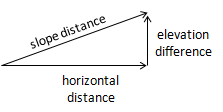3. Grade
a. Definition
Grade is the slope of a straight line and is computed from:
 |
Equation A-1 |
| elev diff: elevation difference horiz dist: horizontal distance |
|
If the elev diff and horiz dist are both in feet (or meters) Equation A-1 results in grade as a dimensionless ratio; multiplying it by 100 converts it to a percentage (%).
If elev diff is feet and hori dist is stations, Equation A-1 returns grade as a percentage.
Grade is positive (+) going uphill in the direction of stationing, negative (-) going downhill, Figure A-7.
 |
| Figure A-7 Grade |
b. Examples
(1) The elevation at sta 10+25.00 is 1214.80 ft; at sta 12+75.00 it is 1193.50 ft.
What is the grade of the line between the two stations?
First, draw a sketch:

Using Equation A-1:

(2) At sta 16+50.00 the elevation is 867.50 ft. If the grade through 16+50.00 is +3.00%, what is the elevation at sta 19+00.00?
Sketch:

We need to rearrange Equation A-1 to solve for the elevation difference between the two stations:

| The horizontal distance is |  |
| and elevation difference is |  |
| and elevation at 19+00.00 |  |
According to the sketch, 19+00 is higher than 16+50 so the computed elevation looks correct
(3) Using the data in example (2), what is the elevation at station 14+00?
Sketch:

The horizontal distance is:

Since we're going backwards along the alignment, the distance is negative.
The elevation is:

From the sketch we see that 14+00 is lower than 16+50, so the computed elevation looks correct.